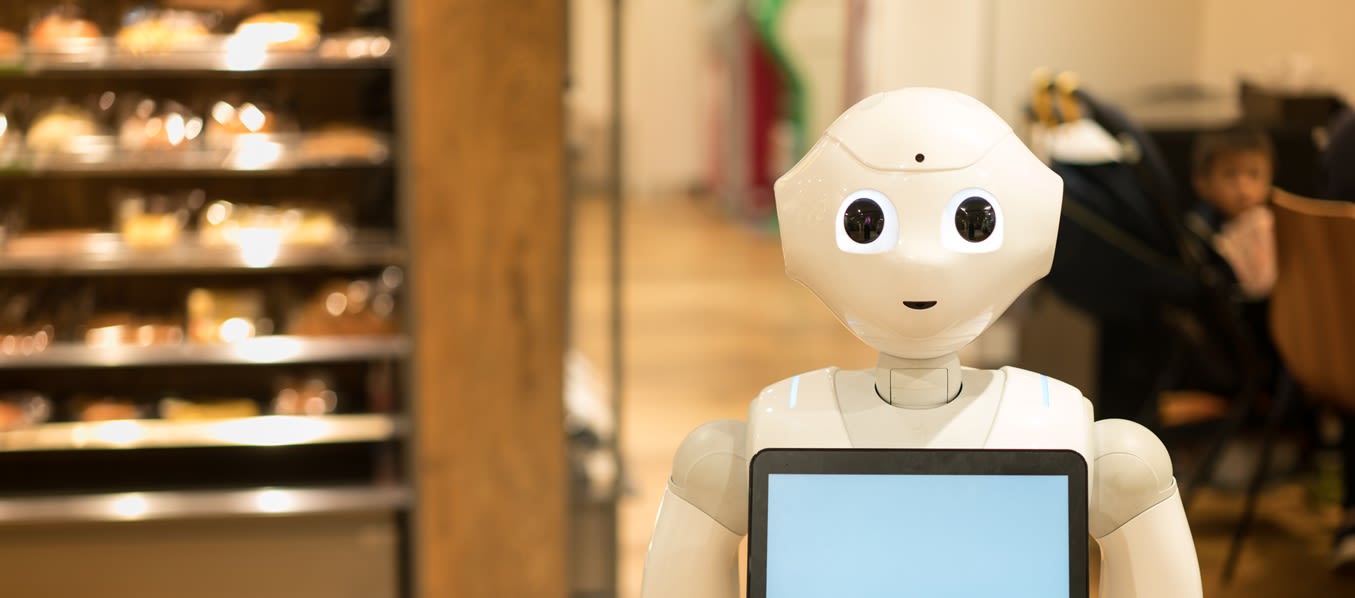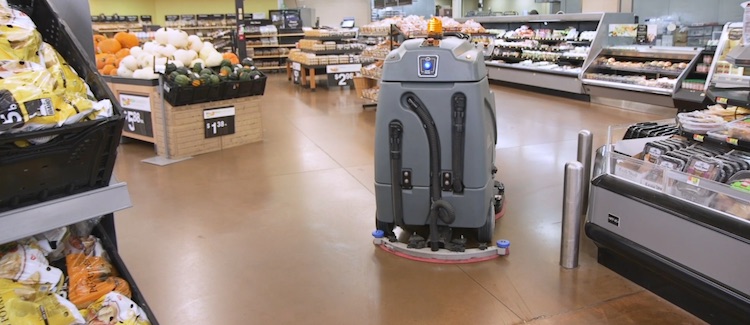- Bossa Nova Robotics News Blog
- Bossa Nova Robotics Competitors
- Bossa Nova Robotics Drivers
- Bossa Nova Robotics
- Bossa Nova Robotics Stock
Comma.ai, a startup created by iPhone hacker George Hotz, has built a self-driving car almost entirely with CNNs that train the car how to drive.They drive the car around, and the car learns from the humans driving it what to do when it sees things in the field of view. The new robots, designed by San Francisco-based Bossa Nova Robotics Inc., join the ranks of Walmart’s increasingly automated workforce, which also includes devices to scrub floors, unload trucks. BOLERO Lite is an imaging system dedicated to quickly and efficiently discriminate fly-away/frizz frizz fibers from the bulk of hair swatches on a 2D image.
As Tally patrols the aisles of a Schnucks grocery store, it monitors the inventory. Photo: Simbe Robotics
Dec 19, 2019
While that is true, it is only part of the story. The real driver behind retail robots is inventory management. It represents the perfect storm of data science, sensors, robotics, and the cloud.
Retail inventory management is tricky, even under the best circumstances, said Jeff Gee, co-founder of Simbe Robotics, a company that has developed an inventory management robot. Stores know when products arrive and when they are sold, but they find it difficult to tally what happens between those two points in time.
That information is critical because it provides merchants with solutions to manage their shelves more efficiently, Gee said.
Misplaced or incorrectly priced products cost merchants money because customers cannot find what they are looking for.
Further reading: Robot Firefighter That Saved Lives
Stores now rely on hourly employees to manage and track inventory. The work is tedious and often leads to errors, said Eugene Kublanov, a principal consultant in procurement and business services at KPMG, a global professional services firm. He believes inventory tracking could benefit from automation.
“Over the past five years, technology has advanced in terms of computing power and cloud technologies to really enable the adoption of robotics in retail,” he said. “The technology is there and proven. Inventory management and material stock issues cost the retail industry billions of dollars each year, so having a robot that can more efficiently and accurately track inventory data is going to be an advantage.”
Enter Tally, Simbe Robotics’ fully automated shelf-auditing robot. It uses a combination of sensors, computer vision, and data tracking algorithms to manage a store’s complete inventory. It smoothly glides up and down grocery store aisles like a taller, thinner version of WALL-E’s girlfriend, EVE.

As Tally navigates the aisles, it notes misplaced, mispriced, and missing items, items that are flying off the shelves and other products that are not moving at all. The data helps retailers make faster and smarter decisions about when to restock.
What’s more, Tally easily—and safely—navigates the complex environment of a grocery store.
“From the beginning, we understood that the robot would have to be small, compact, slim, and agile, and that it would have to share space with humans,” Gee said. “The hardware was specifically designed so it can navigate the store safely and capture data at the same time.”
Tally boasts a suite of cameras and sensors to do this. This starts with LIDAR (light detection and ranging) sensors to identify obstacles and humans in order to plan a safe course.
You May Also Like: Bacteria-Killer Robot Armed with Ultraviolet Light
The top of the robot features ultrasonic and depth and stereo vision cameras to collect inventory data. By analyzing this data, retailers can develop the most efficient plan to fill their shelves.
“All of these different sensors and cameras are packaged very carefully in optimized places on Tally, so they can do what they need to do,” Gee said.
Simba recently raised $26 million in initial (Series A) venture capital funding and signed an inventory financing deal with Softbank Robotics that will enable it to manufacture 1,000 Tally robots over the next two years.
The company is currently running trials at two grocery stores, Giant Eagle and Schnucks, and a large sporting goods store, Decathlon. Its business model is to sell Tally as part of its data analytics services for restocking management.
Tally is not the only inventory management robot on the block. This year, Walmart announced that it would deploy Bossa Nova’s shelf scanning robot at 300 locations. Ahold Delhaize, which owns Food Lion, Giant, and Stop & Shop in the United States, ordered 500 Marty robots from Badger Technologies.
 Editor's Pick: Robots that Weld, Clean, and Coat
Editor's Pick: Robots that Weld, Clean, and CoatRobots are not the only way to go. Earlier this year, Walmart opened an experimental store that combines artificial intelligence with thousands of cameras to monitor shelves less obtrusively.

Bossa Nova Robotics News Blog
Intense competition will likely lead to a features war among robot makers. Yet, when asked if Simbe plans to extend Tally’s functionality to include some kind of reaching or grasping capability to physically restock the shelves it now only audits, Gee immediately replied, “No.”Bossa Nova Robotics Competitors
“People like to anthropomorphize robots and so I can see why they might think Tally will eventually get arms,” he replied. “But as a data capture platform, we just don’t need them. Tally wasn’t designed to use arms and it doesn’t need arms to do what it does.“Rather, we want to extend Tally’s sensing capabilities. We’re looking at how to best check temperatures in the refrigerated and frozen food aisles. We want to know the best technologies to look at produce to see what’s fresh and what’s not. There are so many applications in retail where the right sensors can capture data and help the stores manage what’s happening on the floor.

Bossa Nova Robotics Drivers
“We are listening carefully to our customers to understand what it is they really need and then figure out a way to engineer a solution to make it happen. We don’t need arms to do that,” Gee said.
Kayt Sukel is a science and technology writer based outside Houston, Texas.
Related Content
Robots are not moving into retail as quickly as some technology and industry observers expected. Walmart Inc. has ended its contract with Bossa Nova Robotics Inc., according to The Wall Street Journal. Bossa Nova, a spinout of Carnegie Mellon University’s Robotics Institute, had provided autonomous mobile robots to take inventory in Walmart retail stores.
This is a significant reversal from plans announced in January to expand deployments of Bossa Nova’s robots from 500 to 1,000 stores. The company, which has offices in Mountain View, Calif., and Leetsdale, Pa., had also developed a taller, thinner robot to better scan products on more shelves in narrower aisles.
Bentonville, Ark.-based Walmart decided to end its five-year contract with Bossa Nova rather than renew or expand it, saidThe Wall Street Journal. The retail giant started the program in 2017 but had “found different, sometimes simpler solutions that proved just as useful, said people familiar with the situation,” the WSJ said. These included using human employees for monitoring inventory, which can be a tedious task but requires sophisticated vision for handling exceptions, misplaced items, and obscured labels.
Bossa Nova Robotics
In addition, John Furner, U.S. chief executive at Walmart, was reportedly concerned about shoppers’ perceptions of robots. By contrast, industry observers were bullish on robotics in retail at the National Retail Federation conference in January, before the COVID-19 pandemic affected historically low unemployment and shifted demand from brick-and-mortar stores to online.
Bossa Nova’s mobile shelf-scanning robot at work in a Walmart store. Source: Bossa Nova Robotics
Bossa Nova lays off staffers; Walmart continues to use robots

The end of Walmart’s contract with Bossa Nova apparently led the robotics provider to lay off 50% of its staff, said the WSJ. The company, which raised $29 million in July 2018, is seeking other partners for its mobile robots and software, which it said can provide more accurate, up-to-date information about the state of inventory and help with restocking, returns, and supply chain management.
However, Walmart will continue to use other robots, including cleaning robots using the BrainOS autonomy software from Brain Corp. It also tested the Alphabot goods-to-person system for online grocery orders in 2018 and launched the Intelligent Retail Lab in 2019.
Robotics-as-a-service (RaaS) providers must address cost pressures and the technical challenges of deploying and managing fleets of mobile robots and sensors, not to mention interoperability with existing enterprise software and other automation. The accelerating shift to e-commerce order fulfillment has also shaped robotics investments this year.
“I cannot comment on Walmart. However, the pandemic has forced us to streamline our operations and focus on our core technologies,” said Sarjoun Skaff, co-founder and chief technology officer of Bossa Nova Robotics. “We have made stunning advances in AI and robotics.”
“Our retail AI is the industry’s best and works as well on robots as with fixed cameras, and our hardware, autonomy and operations excelled in more than 500 of the world’s most challenging stores,” he told The Robot Report. “With the board’s full support, we continue deploying this technology with our partners in retail and in other fields.”
Bossa Nova Robotics Stock
Related content:The Robot Report Podcast: Analyzing retail robotics; autonomous yard trucks from Outrider
